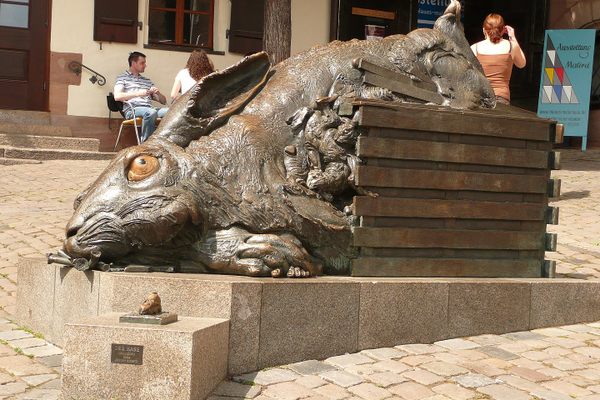Found: Britain’s First Pet Bunny
The rabbit was pampered and definitely not butchered.

Fay Worley had come to the archives in pursuit of brown hare bones. Worley, who works as a zooarchaeologist at Historic England, wanted to run new DNA tests on these bones, which had been collected from Roman sites in Britain, to confirm the animals’ species. Upon opening one box, Worley found a fragment that seemed too small to have come from a hare, and told her colleagues, “I think this might be a rabbit.”
The researchers sent the tiny tibia out for radiocarbon dating and genetic analysis, worried that the bone might have come from another, less ancient bunny. But the resulting analysis proved Fay right and revealed that the rabbit lived in the first century, suggesting that rabbits came to Britain 1,000 years earlier than previously believed. As far as the archaeological record is concerned, this bone came from the first British bunny.
Archaeologists first uncovered the fragment of the bunny bone in 1964, during an excavation of Fishbourne Roman Palace in West Sussex, England. But they stored it in a box where it gathered dust for decades until Worley re-examined the bone in 2017. “The bone had remained unrecognised in the box for 55 years, around twice as long as the Flavian Palace was occupied,” writes Naomi Sykes, an archaeologist from the University of Exeter who is leading the work, in an email. The bone fragment itself is small, just four centimeters, so it’s easy to see how someone could have missed it.
Rabbits are native to Iberia, a peninsula that includes parts of Spain, Portugal, and France. Historians previously believed the Romans introduced the rabbits during the medieval period. This estimate originated from the writings of the Roman scholar Marcus Terentius Varro, who wrote that legions of Romans brought the critters from Spain to serve as a gourmet dish.

According to the researchers’ analysis, Britain’s first bunny was, perhaps unsurprisingly, rather pampered. The largest residential Roman building ever discovered in Britain, the opulent Fishbourne palace contained intricate mosaics of dolphins and geometric box hedges. The rabbit would likely have been an exotic new addition in the palace’s sprawling menagerie, which included fallow deer from Turkey and brown hares from Germany, Sykes says. The bone bore no evidence of butchery, and a special signature in its bones pointed to another, more putrid indication of its domesticity. “When they are in a hutch they tend to eat their own poo,” Sykes told the BBC. “Wild rabbits don’t do that to the same extent.”
Since the first century, rabbits have become a lovable scourge, costing Britain over £260 million a year. Victorian England became enthralled with breeding fancy rabbits, leading to variations such as the extremely cute and useless English lop. Nineteenth-century breeders even developed a template for what they called the “Ideal English Rabbit,” which features a precise constellation of 33 spots and a butterfly-shaped mark on its nose.
The researchers will continue to study the bunny tibia to learn more about its genetic background and its possible relation to modern rabbits. The bone will be on view at Fishbourne this coming week in celebration of Easter. You can also see a 3D model of the bone here, though it’s regrettably not as cute as a real bunny.











Follow us on Twitter to get the latest on the world's hidden wonders.
Like us on Facebook to get the latest on the world's hidden wonders.
Follow us on Twitter Like us on Facebook